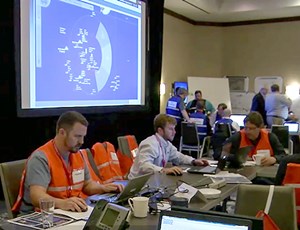Offshore in Depth
After the Deepwater Horizon blowout on the Macondo well seven years ago, the offshore oil and gas industry had to redouble its efforts to protect people, property and the environment in the Gulf of Mexico from the effects of subsea incidents. To receive a drilling permit for a well in the Gulf, operators are required to submit a response plan—a Regional Containment Demonstration—for approval by the federal Bureau of Safety and Environmental Enforcement (BSEE). Operators must demonstrate that they have quick access to the experts and equipment needed to cap a blowing well and contain a spill.

To meet this requirement, two consortia of operating companies were formed to share the cost of assets and intellectual resources needed for rapid response, and to provide mutual aid in support of any member that experiences an incident. Marine Well Containment Company is funded by 10 operators, primarily major oil companies, and has invested over $1 billion. HWCG LLC is a consortium of 16 independent operators, including LLOG, Murphy, Marathon, Stone Energy, and W&T Offshore.
A consortium of independents. HWCG LLC was formed to respond quickly to subsea incidents in water depths as great as 10,000 ft, with the objective of capping a well anywhere in the Gulf within two weeks of an incident. HWCG’s dedicated, joint command center is located at the PetroSkills Conference Center in Katy, Texas. HWCG has a shared pool of assets, personnel and technical resources to support member companies. HWCG has two dual-ram capping stacks, and vessels to capture and process 130,000 bpd of fluid and 220 MMcfgd. Its response vessels work daily in the Gulf and can mobilize quickly, along with experienced crews, as needed. The consortium also has relationships with more than 30 service companies, including well control experts, engineering companies, drilling contractors and marine support companies.
An approved plan, equipment, and resource commitment are not enough to ensure a quick, effective response to a sudden emergency. Member companies must conduct regular drills to step through the planned collaborative effort, understand the technical and resource requirements, and deal with unexpected conditions that are likely to occur in any scenario. On May 9-10, 2017, the HWCG LLC consortium held its eighth annual source control drill in Houston.
Source control drill. In advance of the two-day drill, a team of 20 HWGC experts worked for several months to design the complex scenario for the group exercise, involving a subsea blowout of a 20,000-ft well in 5,000 ft of water. Stone Energy acted as the “responsible party” in the simulation, and more than 250 people from Stone, the remaining 15 member companies, BSEE, the U.S. Coast Guard and numerous service companies participated. Observers from non-member oil companies, well containment organizations and the Texas General Land Office also attended.
Instead of operating from the consortium’s Katy headquarters, the HWGC team set up three local area networks (LANs) in a Houston hotel to replicate remote operations during an incident. They also established videoconference links to Stone Energy’s Incident Command Structure in Lafayette and to BSEE headquarters in Washington, D.C.
Drill participants included technical experts, evaluators, facilitators and observers. Various teams worked on different aspects of the response, including overall project management; analyzing the well design and reservoir pressures to calculate expected flowrates; mobilizing vessels and support equipment; deploying ROVs for subsea operations; removing any tubulars from the sea floor; setting the capping stack; capturing fluids; responding to surface spills; and designing a relief well to permanently kill the well. Designated teams focused on community relations and interfacing with regulators. In parallel with the source containment drill, HWCG conducted a workshop to familiarize members with dispersants, as well as planning for their use, and monitoring their effectiveness in dealing with spills during subsea incidents.
Effective mutual aid. According to David Coatney, Managing Director of HWCG, “The drill showed the effective integration of the consortium’s mutual aid assets into the operator’s crisis management team. It achieved effective communication between the source control group and the supporting organizations, and demonstrated that a pre-planned response will provide satisfactory containment, in the unlikely event of a subsea blowout.”
“While the drill provides one of the most effective training opportunities for the industry, we work all year long to improve our response system,” said Mike Noel, HWCG’s commercial director. He also pointed out that operating companies do not rely on the consortium’s annual drill. “Each member company also undertakes multiple drills every year, unique to their operations, so they are ready to respond to crises,” he said. ![]()

- Applying ultra-deep LWD resistivity technology successfully in a SAGD operation (May 2019)
- Adoption of wireless intelligent completions advances (May 2019)
- Majors double down as takeaway crunch eases (April 2019)
- What’s new in well logging and formation evaluation (April 2019)
- Qualification of a 20,000-psi subsea BOP: A collaborative approach (February 2019)
- ConocoPhillips’ Greg Leveille sees rapid trajectory of technical advancement continuing (February 2019)


